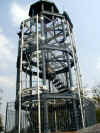 |
New York
Architecture Images-Harlem and the Heights Fire Watch Tower Landmark |
|
architect |
engineer Julius Kroehl |
|
location |
On the highest point of Marcus Garvey Park, around W. 121st to W. 122nd Streets |
|
date |
1855 |
|
style |
|
|
construction |
Cast Iron |
|
images |
 |
|
|
|
|
Long before the
advent of the modern methods of fighting fires, it was common to build
tall bell towers for the purpose of spotting fires and summoning
volunteer firefighters. Men employed as bell ringers would spend long
shifts on the lookout, with minimum protection from the elements
provided by the enclosure at the top. If a fire was sited, they would
send out an alarm by ringing the bell. Someone from the fire station
would run to the tower to receive the location of the fire, and the
horse-drawn fire wagon would rush to the scene. Bucket brigades would
form at the fire and attempt to douse the blaze.
The City of New York sponsored a competition early in 1855 to erect a fire bell tower in Mount Morris Square. Although virtually unknown, a design by engineer Julius Kroehl won out over the more famous James Bogardus. To this day, Bogardus is widely known for his pioneering designs in cast-iron construction, many of which still survive in New York's SoHo district. Kroehl's tower rises 47 feet, given extra viewing advantage by the higher elevation of the site. In 1851, a telegraph alarm system was established but the bell was still rung to call out the local firemen, a volunteer force until 1868. As the City's real estate developed, building heights increased and the view from the fire towers became increasingly obscured. In the 1870's, the street alarm box system was expanded. By 1880, all fire watchmen were discharged and the towers demolished as the properties on which they sat were developed. The last of these civic monuments remaining in the five boroughs, the Mount Morris bell tower is also the oldest cast-iron structure in New York City and is a source of pride for the neighborhood. It's existence was saved from developers largely because it was not in the way of development but also due to the massive rock outcropping on which it rests. The rock would be expensive and difficult to remove, even with today's technology. It was designated a landmark in 1976 by the New York City Landmarks Preservation Commission. |
|
|
links |
|
| With special thanks to www.nyc.gov | |